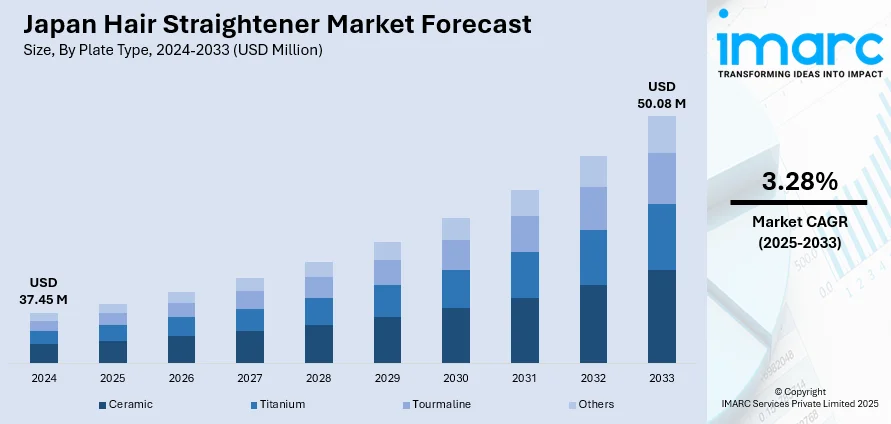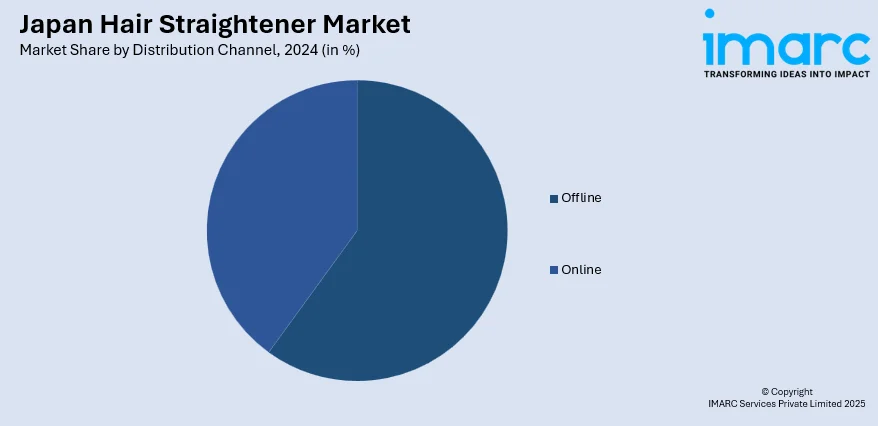
Japan Hair Straightener Market Size, Share, Trends and Forecast by Plate Type, Distribution Channel, End User, and Region, 2025-2033
Japan Hair Straightener Market Overview:
The Japan hair straightener market size reached USD 37.45 Million in 2024. Looking forward, IMARC Group expects the market to reach USD 50.08 Million by 2033, exhibiting a growth rate (CAGR) of 3.28% during 2025-2033. At present, increasing interest in personal grooming and hairstyling is driving the demand for easy-to-use, salon-like tools at home. Besides this, the broadening of retail outlets, which aid in enhancing product availability across various channels, is contributing to the expansion of the Japan hair straightener market share.
|
Report Attribute
|
Key Statistics
|
|---|---|
|
Base Year
|
2024
|
|
Forecast Years
|
2025-2033
|
|
Historical Years
|
2019-2024
|
| Market Size in 2024 | USD 37.45 Million |
| Market Forecast in 2033 | USD 50.08 Million |
| Market Growth Rate 2025-2033 | 3.28% |
Japan Hair Straightener Market Trends:
Rising interest in personal grooming and hairstyling
Increasing interest in personal grooming and hairstyling is positively influencing the market in Japan. As individuals are paying more attention to appearance and self-care, especially in urban areas, they are seeking products that help them achieve sleek and stylish hair daily. Hair straighteners are becoming popular among young adults and working professionals who prefer quick grooming solutions. The trend of experimenting with different hairstyles is also encouraging the utilization of versatile styling tools. Manufacturers are responding by offering compact, travel-friendly, and damage-control devices that suit modern lifestyles. Rising disposable incomes are supporting spending on personal care electronics, making high-quality straighteners more accessible. Men, too, are contributing to this shift, as grooming is becoming gender neutral. The convenience of at-home hairstyling, combined with rising awareness about hair care and appearance, is strengthening the market appeal. As beauty and personal care routines are becoming a daily ritual, the demand for reliable, safe, and efficient hair straighteners continues to rise across Japan, making personal grooming a key driver of market growth. As per industry reports, the Japan beauty and personal care products market size is set to attain USD 36.93 Billion by 2029, growing at a CAGR of 2.87% during the forecast period (2024-2029).

To get more information on this market, Request Sample
Expansion of retail channels
The broadening of retail channels is impelling the Japan hair straightener market growth. According to the IMARC Group, the Japan retail market size reached USD 1,779.7 Billion in 2024. As more beauty and electronics stores are opening in urban and suburban areas, people are gaining easier access to a wide range of hair straighteners. Retail outlets offer in-store demonstrations, helping buyers understand features and performance before purchase. Department stores, specialty beauty shops, and supermarkets stock both domestic and international brands, creating more choices for customers. Retail expansion also supports competitive pricing and promotional offers, attracting budget-conscious shoppers. Improved visibility in stores encourages impulse purchases and enhances brand recognition. Additionally, partnerships between manufacturers and retail chains boost product placement and customer engagement.
Increasing endorsements by celebrities and influencers
Endorsements by celebrities and influencers are positively influencing the market. When well-known personalities showcase hair straighteners on social media, television, and online platforms, it builds trust and encourages fans to try those brands. Influencer marketing highlights product benefits like smooth results, heat protection, and styling ease, which resonates with beauty-conscious users. These endorsements often include tutorials and personal experiences, making the products more relatable. Young population, in particular, is drawn to items promoted by trendsetters they follow. Brands are collaborating with influencers for limited editions or co-branded products, creating excitement and urgency. This strategy boosts brand awareness and strengthens customer loyalty. With the rising number of social media users, the market continues to expand. As per industry reports, as of March 2024, approximately 96 Million individuals, which accounted for 78.1% of the overall Japanese population, engaged with social media.
Japan Hair Straightener Market Segmentation:
IMARC Group provides an analysis of the key trends in each segment of the market, along with forecasts at the country and regional levels for 2025-2033. Our report has categorized the market based on plate type, distribution channel, and end user.
Plate Type Insights:
- Ceramic
- Titanium
- Tourmaline
- Others
The report has provided a detailed breakup and analysis of the market based on the plate type. This includes ceramic, titanium, tourmaline, and others.
Distribution Channel Insights:

- Offline
- Online
A detailed breakup and analysis of the market based on the distribution channel have also been provided in the report. This includes offline and online.
End User Insights:
- Household
- Commercial
The report has provided a detailed breakup and analysis of the market based on the end user. This includes household and commercial.
Regional Insights:
- Kanto Region
- Kansai/Kinki Region
- Central/ Chubu Region
- Kyushu-Okinawa Region
- Tohoku Region
- Chugoku Region
- Hokkaido Region
- Shikoku Region
The report has also provided a comprehensive analysis of all the major regional markets, which include Kanto Region, Kansai/Kinki Region, Central/Chubu Region, Kyushu-Okinawa Region, Tohoku Region, Chugoku Region, Hokkaido Region, and Shikoku Region.
Competitive Landscape:
The market research report has also provided a comprehensive analysis of the competitive landscape. Competitive analysis such as market structure, key player positioning, top winning strategies, competitive dashboard, and company evaluation quadrant has been covered in the report. Also, detailed profiles of all major companies have been provided.
Japan Hair Straightener Market Report Coverage:
| Report Features | Details |
|---|---|
| Base Year of the Analysis | 2024 |
| Historical Period | 2019-2024 |
| Forecast Period | 2025-2033 |
| Units | Million USD |
| Scope of the Report |
Exploration of Historical Trends and Market Outlook, Industry Catalysts and Challenges, Segment-Wise Historical and Future Market Assessment:
|
| Plate Types Covered | Ceramic, Titanium, Tourmaline, Others |
| Distribution Channels Covered | Offline, Online |
| End Users Covered | Household, Commercial |
| Regions Covered | Kanto Region, Kansai/Kinki Region, Central/Chubu Region, Kyushu-Okinawa Region, Tohoku Region, Chugoku Region, Hokkaido Region, Shikoku Region |
| Customization Scope | 10% Free Customization |
| Post-Sale Analyst Support | 10-12 Weeks |
| Delivery Format | PDF and Excel through Email (We can also provide the editable version of the report in PPT/Word format on special request) |
Key Questions Answered in This Report:
- How has the Japan hair straightener market performed so far and how will it perform in the coming years?
- What is the breakup of the Japan hair straightener market on the basis of plate type?
- What is the breakup of the Japan hair straightener market on the basis of distribution channel?
- What is the breakup of the Japan hair straightener market on the basis of end user?
- What is the breakup of the Japan hair straightener market on the basis of region?
- What are the various stages in the value chain of the Japan hair straightener market?
- What are the key driving factors and challenges in the Japan hair straightener market?
- What is the structure of the Japan hair straightener market and who are the key players?
- What is the degree of competition in the Japan hair straightener market?
Key Benefits for Stakeholders:
- IMARC’s industry report offers a comprehensive quantitative analysis of various market segments, historical and current market trends, market forecasts, and dynamics of the Japan hair straightener market from 2019-2033.
- The research report provides the latest information on the market drivers, challenges, and opportunities in the Japan hair straightener market.
- Porter's five forces analysis assist stakeholders in assessing the impact of new entrants, competitive rivalry, supplier power, buyer power, and the threat of substitution. It helps stakeholders to analyze the level of competition within the Japan hair straightener industry and its attractiveness.
- Competitive landscape allows stakeholders to understand their competitive environment and provides an insight into the current positions of key players in the market.
Need more help?
- Speak to our experienced analysts for insights on the current market scenarios.
- Include additional segments and countries to customize the report as per your requirement.
- Gain an unparalleled competitive advantage in your domain by understanding how to utilize the report and positively impacting your operations and revenue.
- For further assistance, please connect with our analysts.
 Request Customization
Request Customization
 Speak to an Analyst
Speak to an Analyst
 Request Brochure
Request Brochure
 Inquire Before Buying
Inquire Before Buying




.webp)




.webp)












